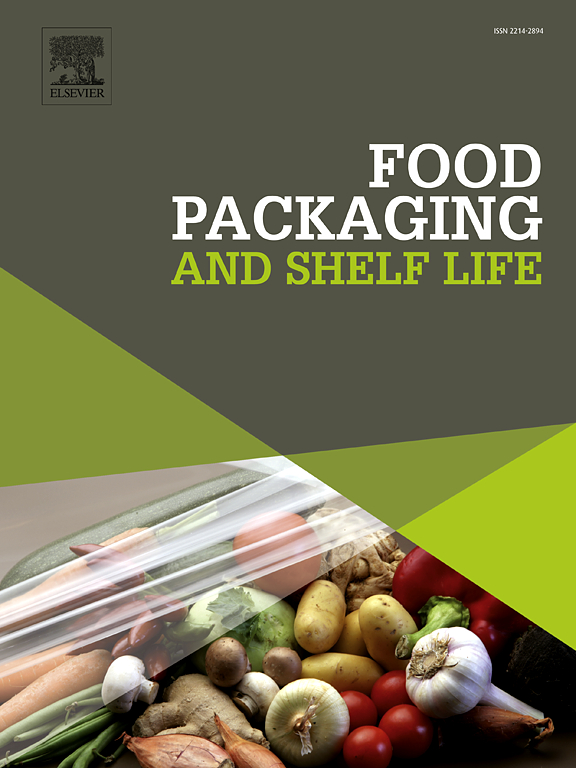Development of PLA-based bilayer nanofibers containing ZIF (zeolitic imidazolate framework)-67 nanoparticles for active food packaging applications in citrus preservation
IF 8.5
1区 农林科学
Q1 FOOD SCIENCE & TECHNOLOGY
引用次数: 0
Abstract
In this study, antimicrobial monolayer and bilayer nanofibers were developed from poly(lactic acid) (PLA) by incorporating zeolitic imidazolate framework-67 (ZIF-67) nanoparticles via electrospinning for active food packaging. ZIF-67 nanoparticles were synthesized under varying conditions, and their physicochemical properties were thoroughly characterized. Active monolayer PLA nanofibers were produced by directly electrospinning a PLA solution containing ZIF-67 nanoparticles, while bilayer fibers were formed by electrospinning ZIF-67 onto the surfaces of pure PLA nanofibers. The diameter and surface porosity of the fibers were affected by both the concentration of PLA and the content of ZIF-67 nanoparticles. Incorporation of ZIF-67 nanoparticles increased the tensile strength of monolayer and bilayer fibrous films by 3 and 4.5-fold, respectively, compared to pure PLA fibrous films, while slightly reducing their elongation at break. The composite bilayer films showed a controlled release of cobalt ions at pH 7.5 over 12 days. ZIF-67-loaded PLA nanofibers produced by two methods exhibited enhanced antimicrobial effects against Escherichia coli and Staphylococcus aureus compared to pure PLA. Citrus fruits coated with monolayer and bilayer PLA nanofibers had significantly lower weight losses of 1.18 % and 3.20 %, respectively, in comparison with uncoated citrus fruits, which reached 15.09 % after 20 days of storage at 25 °C. ZIF-67-loaded PLA fibrous films preserved color, reduced weight loss and delayed the decrease in firmness, and prevented mold growth on the surface over 20 days storage at 25 °C. These results demonstrate the potential of ZIF-67-loaded PLA nanofibers for active food packaging applications with good antimicrobial effects.
含ZIF -67纳米颗粒的聚乳酸双层纳米纤维在柑橘保鲜食品包装中的应用
本研究以聚乳酸(PLA)为原料,采用静电纺丝法将沸石咪唑酸框架-67 (ZIF-67)纳米颗粒掺入其中,制备了抗菌单层和双层纳米纤维,用于活性食品包装。在不同条件下合成了ZIF-67纳米颗粒,并对其理化性质进行了全面表征。在含有ZIF-67纳米粒子的PLA溶液中直接静电纺丝制备了活性单层PLA纳米纤维,而在纯PLA纳米纤维表面静电纺丝制备了活性双层PLA纳米纤维。PLA浓度和ZIF-67纳米颗粒含量对纤维直径和表面孔隙率均有影响。ZIF-67纳米颗粒的掺入使单层和双层纤维膜的拉伸强度分别比纯PLA纤维膜提高了3倍和4.5倍,同时略微降低了断裂伸长率。在pH值为7.5的条件下,复合双层膜在12天内可控制钴离子的释放。与纯PLA相比,两种方法制备的负载zif -67的PLA纳米纤维对大肠杆菌和金黄色葡萄球菌的抗菌作用增强。经单层和双层PLA纳米纤维包膜的柑橘果实在25 °C条件下储存20 d后,其失重率分别为1.18 %和3.20 %,显著低于未包膜的柑橘果实,其失重率为15.09 %。负载zif -67的PLA纤维膜保持了颜色,减少了重量损失,延缓了硬度的下降,并在25 °C下储存20天,防止了表面霉菌的生长。这些结果表明,负载zif -67的聚乳酸纳米纤维具有良好的抗菌效果,在活性食品包装方面具有很大的应用潜力。
本文章由计算机程序翻译,如有差异,请以英文原文为准。
求助全文
约1分钟内获得全文
求助全文
来源期刊

Food Packaging and Shelf Life
Agricultural and Biological Sciences-Food Science
CiteScore
14.00
自引率
8.80%
发文量
214
审稿时长
70 days
期刊介绍:
Food packaging is crucial for preserving food integrity throughout the distribution chain. It safeguards against contamination by physical, chemical, and biological agents, ensuring the safety and quality of processed foods. The evolution of novel food packaging, including modified atmosphere and active packaging, has extended shelf life, enhancing convenience for consumers. Shelf life, the duration a perishable item remains suitable for sale, use, or consumption, is intricately linked with food packaging, emphasizing its role in maintaining product quality and safety.
 求助内容:
求助内容: 应助结果提醒方式:
应助结果提醒方式:


